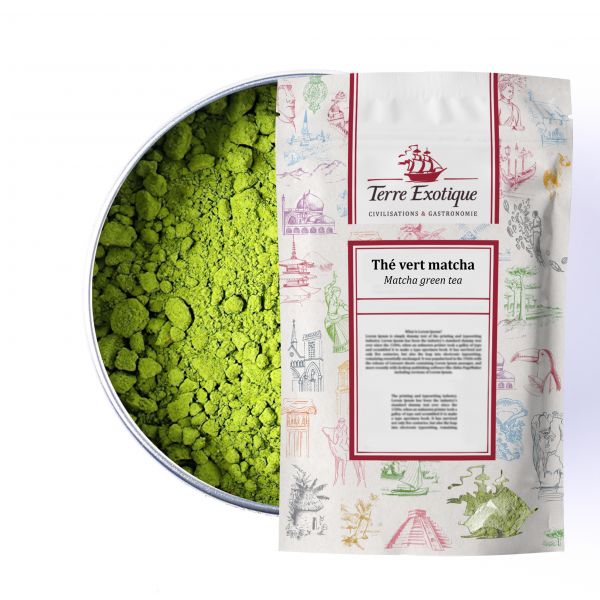





The delicate flavours of this Matcha green tea will delight your pastries and baking!
This extremely fine powder is obtained using a very specific process, liberating all the unusual flavours of Matcha green tea. Use this powder to enchant your pastries, cakes, or mousses!
Matcha tea is grown using a very precise technique
This tea green undergoes a specific age-old process
Uji, in Kyoto prefecture, in the centre of Japan, is the heart of Matcha green tea production. This is the main region of green tea plantations which produce this delicious green tea powder. Green tea is produced using a very specific shading method. Several weeks before the tea is harvested, the tea plants are shaded with a black cover, which acts as a filter for the sun. This forces the tea plants to struggle to grow! This increases the release of amino acids which soften the taste of the tea and give it its beneficial properties. Now that the tea leaves are full of chlorophyll, they are ready to be picked.
A strong tasting fine and very concentrated powder
After they are harvested, the leaves are steamed for a few seconds. This stage stops the oxidation process and ensures that the tea keeps its vibrant green colour. Then the heart of the leaf is separated from the veins, so that only the “tencha”, which is tenderest part of the leaves, is kept. The tencha are then crushed and ground very finely. Traditionally, this is done using two stone grindstones. The powder is as fine a talcum powder.
How to use Matcha green tea in pastries and baking?
Matcha tea adds an elegant original hint to your baking!
Matcha green tea is widely used in Japanese baking, both for its intense green colour and its delicious delicate flavours which will delight your desserts. Use it sparingly, 1 to 4 teaspoons of Matcha is plenty enough depending on the recipe. You can also use it in home-made ice-cream, in sponge cakes, in a panna cotta with coconut or sprinkle it over a gooey chocolate cake. Its gentle delicate notes will enchant many desserts: home-made sorbets, almond financier cakes, macarons, tiramisu… It can of course be used in savoury dishes, with soups, shrimps or with a delicate fish served with a cream sauce.
Matcha green tea, a traditional tea with a Jade green colour!
Matcha tea, is a true art
In Japan, matcha green tea is surrounded by a whole ceremony, inspired by Zen Buddhism. Each gesture has a meaning and refers to different art forms such as painting, architecture, poetry, pottery or calligraphy. This ceremony has been the same for more than 10 centuries. For example, Chan Buddhists drink green tea during sacraments and in the Buddhist culture, matcha brings spiritual elevation.
| Allergen | Absence |
|---|---|
| Native country | JAPON |
| Genus and botanical species | Camellia sinensis |
| Ingredients | matcha green tea |
| Nutritional Info | VN Energie pour 100 g (energy for 100g) : 1355 kJ / 324 kcal VN Matière grasse (fat) : 5.3 g Dont acide gras saturés (of which saturated fat) : 0.3 g VN Glucides (carbohydrate) : 39.5 g Dont sucres (of which sugars) : 6.4 g VN Protéines (protein) : 29.6 g Vn Sel (salt) : 0.02 g |
| TRACES EVENTUELLES D'ALLERGÈNES | céleri, sésame, moutarde, fruits à coques. |
 Français
Français 



